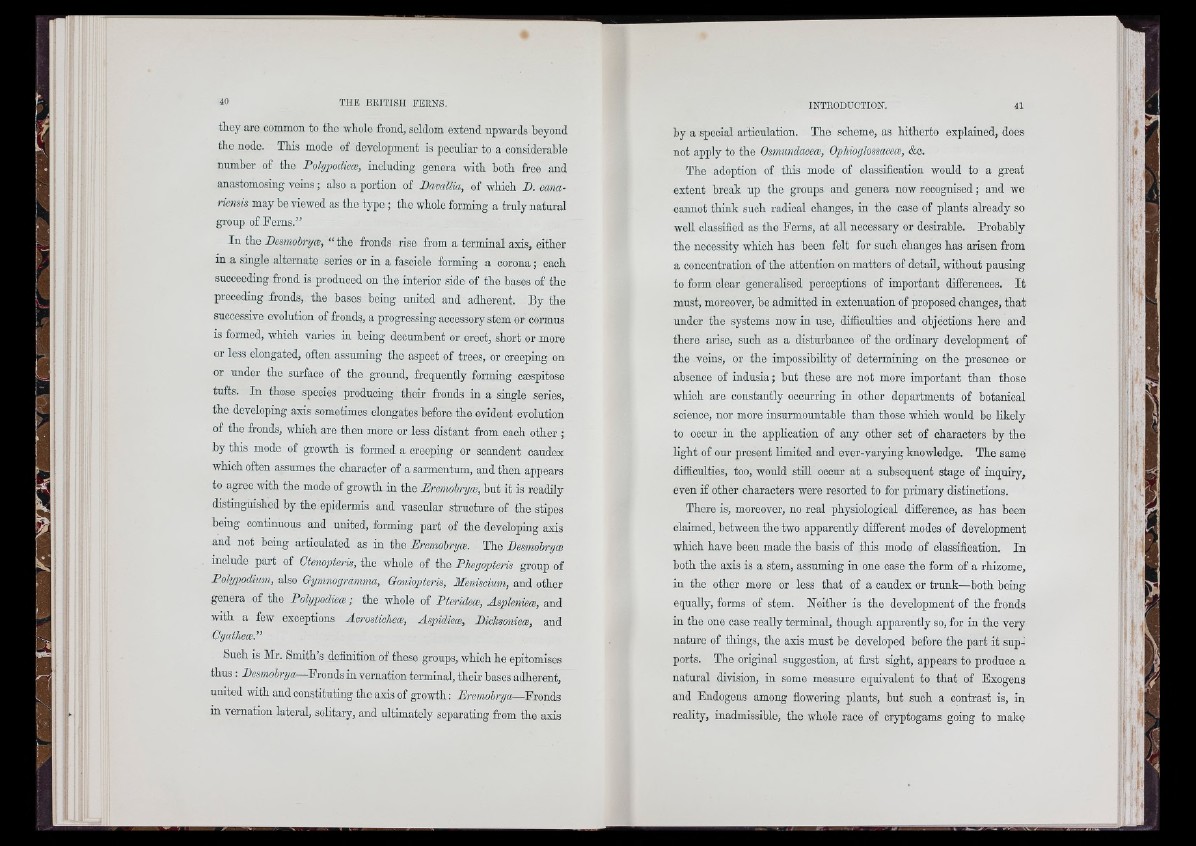
tlioy aro common to the whole frond, seldom extend upwards beyond
tho node. This mode of dovolopmcnt is peculiar to a considerable
number of tho Fohjpodiem, including genera with both froo and
anastomosing veins; also a portion of Bamllia, of which B . eana-
ricnsis may bo viewed as tho type ; the whole forming a truly natural
group of Ferns.”
In tho Besmohnjm, “ the fronds rise from a terminal axis, cither
in a single alternate scries or in a fascicle forming a corona; each
succeeding frond is produced on the interior side of tho bases of tho
preceding fronds, the bases being united and adherent. By the
successive evolution of fronds, a progressing accessory stem or cormus
is formod, which varies in being decumbent or erect, short or more
or loss elongated, often assuming the aspect of trees, or creeping on
or under tho surface of tho ground, frequently forming caespitoso
tufts. In thoso species producing thoir fronds in a single series,
the developing axis sometimes elongates before the evident evolution
of the fronds, which aro then more or less distant from each other ;
by this mode of growth is formed a creeping or scandent caudex
which often assumes the character of a sarmentum, and then appears
to agree with the mode of growth in the Bremobrt/ai, but it is readily
distinguished by the epidermis and vascular structure of the stipes
being continuous and united, forming part of the developing axis
and not hoing articulated as in the Eremobrym. The Besmobrym
include part of Ctenopteris, the whole of the Phegopteris group of
Pohjpodium, also Gymnogramma, Goniopteris, Menisckm, and other
genera of the Polypodiece; the whole of Pteridem, Aspleniem, and
with a few exceptions Aorosticheai, Aspuliew, Biolmniem, and
Cyathem.”
Such is Mr. Smith’s definition of these groups, which he epitomises
thus : Besmobrya—FmnA.s in vernation terminal, thoir bases adherent,
united with and constituting tho axis of growth; Ereniobrya—Fronds
in vernation lateral, sohtary, and ultimately separating from the axis
by a special articulation. Tho scheme, as hitherto explained, docs
not apply to tho Osmimdaoem, Ophioghssacem, &c.
Tho adoption of this mode of classification would to a great
extent break up tho groups and genera now recognised; and we
cannot think such radical changes, in tho case of plants afrcady so
wcU classified as tho Ferns, at aU necessary or desirable. Probably
the necessity which has been felt for such changes has arisen from
a concentration of tho attention on matters of detail, without pausing
to form clear generalised perceptions of important differences. I t
must, moreover, be admitted in extenuation of proposed changes, that
under tho systems now in use, difficulties and objections bore and
there arise, such as a disturbance of the ordinary development of
the veins, or the impossibility of determming on the presence or
absence of indusia; but these aro not moro important than those
which are constantly occurring in other departments of botanical
science, nor more insurmountable than those which would be likely
to occur in the appHcation of any other set of characters by tho
light of our present limited and over-varying knowledge. The samo
difficulties, too, would stUl occur at a subsequent stage of inquiry,
even if other characters were resorted to for primary distinctions.
There is, moreover, no real physiological difference, as has been
claimed, between the two apparently different modes of development
which have been made the basis of this mode of classification. In
both tho axis is a stem, assuming in one case the form of a rhizome,
in tho other more or less that of a caudex or trunk—both being
equally, forms of stem. Neither is tho development of the fronds
in the ono ease roaUy terminal, though apparently so, for in the very
nature of things, tho axis must be developed before the part it supports.
The original suggestion, at first sight, appears to produce a
natural division, in some measure equivalent to that of Exogens
and Endogens among flowering plants, but such a contrast is, in
reality, inadmissible, the whole race of cryptogams going to make